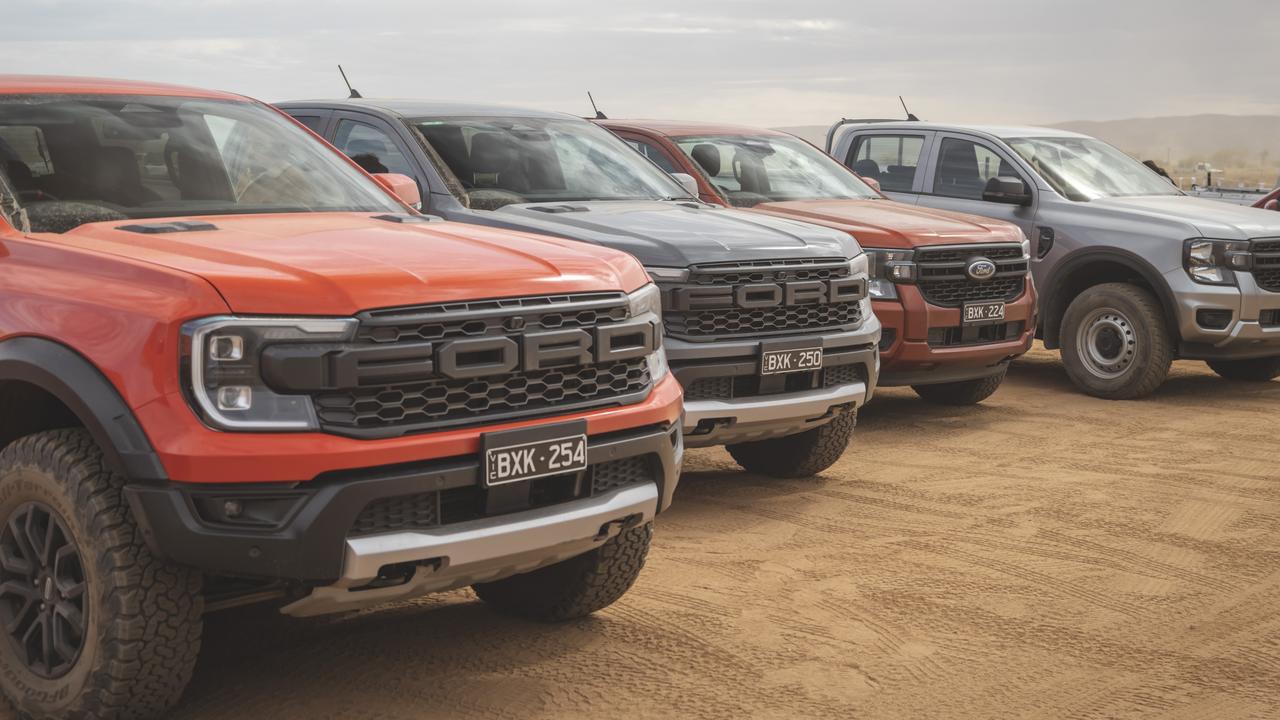The Ford Ranger covers a vast price range – one we’ve put to the ultimate outback test.
We spent a few days testing either end of the Ranger 4WD line-up to work out which is best for rough road work.
Our experiment took place in and around Alice Springs in the Red Centre – the ultimate test for Australia’s top selling 4WD.
So, which is best for those who want to venture beyond the blacktop?
Ford Ranger XL/XLS
The XL is the most affordable way to get into a four-wheel drive Ranger. Prices start at about $57,500 drive-away, although for this test we had the bi-turbo engine that adds about $3500, bringing with it a 10-speed automatic.
It’s a basic ute with steel wheels and no side steps. And the value is questionable, given it’s only another $1000 for the XLS, which has dual-zone ventilation, push-button start, alloy wheels and side steps.
The XL and XLS don’t skimp on safety and connectivity. Each matches or leads the class on crash avoidance systems and connected tech, including FordPass Connect, which allows you to lock and unlock the doors via an app. Plus there’s an 8.0-inch digital instrument cluster and vibrant 10.1-inch central touchscreen packed with useful features.
In either guise, you’d need accessories to prepare it for off-road work. Chunkier tyres and tyre pressure sensors would be a good start, as would some additional recovery hooks for towing it out if you get stuck.
Otherwise, it’s a highly capable off-roader, with excellent ground clearance and a basic but effective part-time four-wheel drive system. A rear differential lock maximises traction in slippery conditions.
It also has a payload of more than one tonne, which will easily take the family, any camping gear and some of those accessories.
Those extra kilograms will improve the ride, too, because the ute is quite stiffly sprung, something that becomes very obvious over rocky trails without a load on board. It’s tough, but a long way from luxurious.
The 2.0-litre bi-turbo engine is stout and smooth but there’s some lag when you first push the throttle. That’s less of an issue on the open road where it’s leisurely but honest.
Claimed fuel use is 7.6 litres per 100km. And while you won’t match that with a fully laden ute, you should still get upwards of 800km from the 80-litre tank.
Ford Ranger Raptor
The Raptor looks tougher because it is.
It rides higher and its wheels have been spaced further apart for a broader footprint. It also comes with BG Goodrich off-road tyres that are made to be punished. Throw in tyre pressure sensors and it means a lot more peace of mind over rocks and gravel.
The Raptor also has some of the world’s most advanced suspension.
The Fox shock absorbers adjust to different terrain and speeds within milliseconds, using advanced computer control.
Bound through a dry river bed or across rugged rocks and its talents soon become apparent. The Raptor copes beautifully and absorbs the bumps then settles, rather than bouncing around. It’s seriously impressive.
The Raptor also has ample power courtesy of its 3.0-litre V6 twin-turbo engine. There’s a fiery 292kW – almost double that of the XL and XLS – and a snarling adjustable exhaust adds to the aural excitement.
But it comes at a penalty. The Raptor is thirsty, using a claimed 11.5L/100km of premium unleaded, so you’ll pay a lot more for that punchy acceleration.
It is, however, terrific for overtaking on long country roads.
The Raptor is also perfectly set up for off-roading, with solid recovery hooks front and rear and an extra 50mm of ground clearance. Throw in an on-demand four-wheel drive system and it’s a better companion for changing road surfaces.
There are also a lot more features – from electric seats to Bang & Olufsen audio – and better tech, including larger screens.
This all comes at a cost. The Raptor is priced at about $95,000 drive-away, almost $40,000 more than the base Ranger.
The Raptor only has a 708kg payload. While that’s still decent, anyone loading up is likely to get close to that once you pack in all the camp gear. Its tow capacity is just 2500kg, too, a full tonne less than other Rangers.
So, which is best?
The suspension alone on the Ranger Raptor is almost enough to justify the hefty ute price tag. It’s next level in the ute category and creates a car that’s brilliantly set up for off-road adventuring. In its standard guise it’s by far the better ute here, as you’d expect it to be.
But the high-performance model comes with compromises, especially around fuel use and how much it can carry.
For that reason the entry-level Rangers may make more sense for those looking to load up for the big trip. They’ll also go further between refills. Just be prepared to spend more adding to the core car’s talents.

